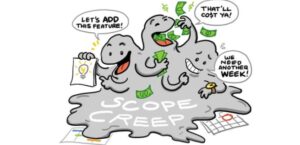Picture this: you’re in full swing with a very promising client, 3 or 4 weeks into your 90-day project. You had a pretty good idea at the beginning of everything about all of the work you needed to get accomplished during your interaction together, but it’s starting to seem like more of an ordeal than it did originally. There were a few backend things that needed attention that you weren’t aware of after your initial “discovery” meeting, and that took some time to get in order. There were a few employees on your client’s team that weren’t exactly as “up to speed” as you had originally thought, and are taking entirely too long to get their end of the work to you. Maybe you or your client is having “shiny object syndrome” and keep jumping from idea to idea instead of staying focused… a million possibilities to slow you down and get in the way.
In the end, the only name that ends up at risk is your own name. You can’t blame your client’s team for being slow, you can’t blame a bad original diagnosis, and you can’t blame the business owner’s shiny object syndrome. Whenever your client sees that you haven’t accomplished “much of anything” in 90 days, it’s going to be you who looks bad and potentially tarnishes that client relationship.
DON’T LET THIS HAPPEN TO YOU!
We’ve come up with the top 5 ways to stay on top of Scope Creep so your client gets their exact desired outcome, and so you can be the proud agency owner to claim the victory.
1. Agree Upon Goals and Expectations For the Project
At the very beginning of your relationship with your client, make sure everyone is aware of the goals you are trying to achieve together. Do you have a very specific project to complete? Make a schedule. Ask them the right questions. What do they want from the “end” of your relationship together? If you know the answer to that question, remind them of that goal any time they have shiny object syndrome and try to get off track. Outline your biggest challenges from the beginning, and make sure you and your client are always on the same page and in healthy communication about those challenges. Make sure there is no crucial or critical information that is being taken for granted. You might assume that your client already knows A, B, or C thing about you and your agency, and your client might assume that you already know A, B, or C thing about their business. Don’t leave anything to the imagination. Break it down. Make sure everyone is aware of the budget boundaries. Breaching a budget is a nightmare, especially if changes to the project comes with extra fees.
2. Don’t Break Process
Making exceptions, even just once or twice, can be deadly. As soon as you break process, you’ve thrown yourself off from what clients normally experience. If you have documents and checklists that each client goes through when they come onboard, during meetings, between meetings, and during every other stage of your relationship, you have expectations of where they are supposed to go next. If you break process “just this once” for one person, it could lead to a snowball effect of getting behind on your project and your client could be tempted to skip other necessary steps of the process as well. Keep everyone on the same path to success – the processes are there for a reason.
3. Record Everything
It’s important to make sure that notes are taken in every meeting. As for us, we record them and take notes as well. That way, there is no confusion over who was supposed to do what, when it was supposed to be finished, and how much it was going to cost. If you have a detailed proposal document that the client signs or initials, you can always refer them to that document if things start getting off track.
4. Keep Track of Work Completed and What’s Left
Don’t be frivolous with your time when you’re working for a client. It’s important that you’re not putting in more hours than you agreed upon at the beginning of your relationship. Even when you’re not *technically* working hourly, it’s important that you break down your estimated hourly rate to see if you’re making more than what you’re spending. Keeping track of your time and work on all of your clients will help you know how to better proceed in the future. Soon enough, you’ll have it boiled down to an exact system and process, and everything will feel more natural and easy.
5. Be Cautious – Don’t Let Your Guard Down
Just expect Scope Creep to find its way into your project. As long as you are aware and cautious going into a project, it’ll be harder for Scope Creep to affect you and your team. I’m not saying that every client should be exactly the same, because I know that a one-size-fits-all approach isn’t good in this industry because everyone has very different needs. What I am saying is this: One tiny change after the other can build up and eat you alive. You just have to make sure to stay on top of everything – set mini-goals and mini-milestones so you can be sure you’re making the progress you’re supposed to be making, and no one can be confused or disappointed at the end of the project.
Overall, keep your clients happy by being organized and caring as much about them and their project as you would if it were you. This is something you no doubt already do. Just strive to be hyper-sensitive to Scope Creep and its effects on your clients and your agency.


![[PODCAST] – Michael Knorr – That Company – The Most Scalable, White Label Provider For SEO, PPC, and Social Media Services](https://marketingagencycoach.com/wp-content/uploads/2021/06/Michael-Knorr-Thumbnail.-1-300x225.jpg)